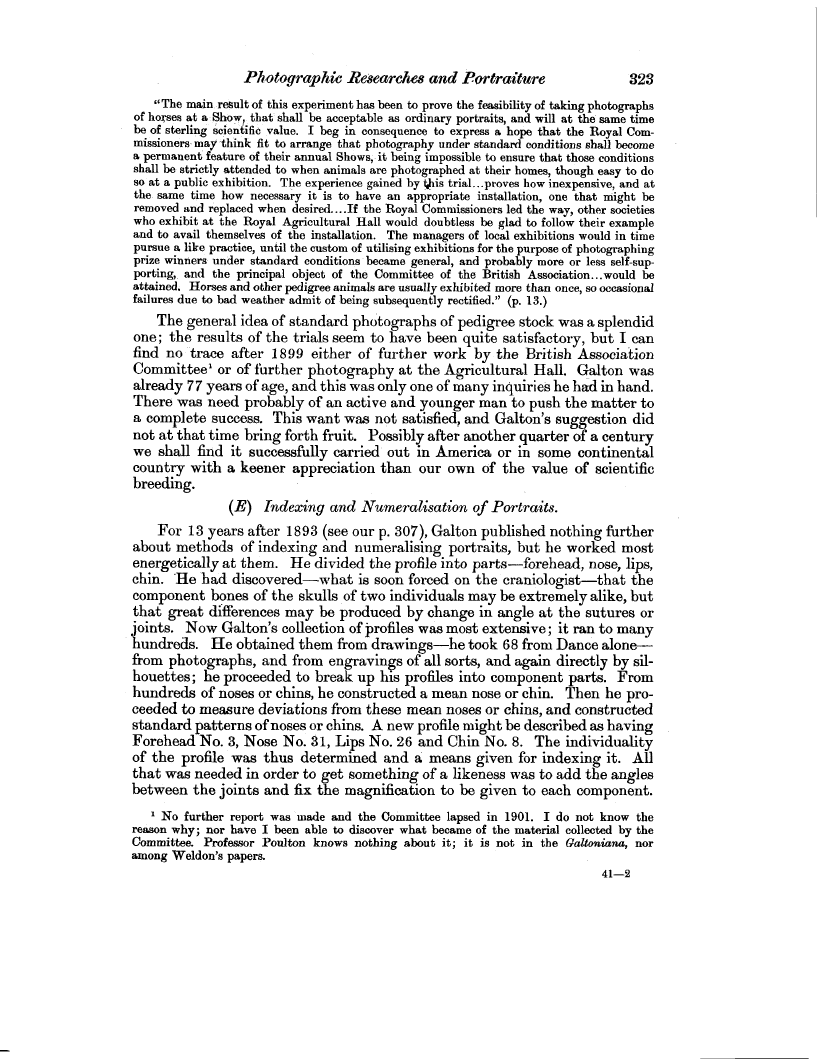Photographic Researches and Portraiture 323
"The main result of this experiment has been to prove the feasibility of taking photographs of horses at a Show, that shall be acceptable as ordinary portraits, and will at the same time be of sterling scientific value. I beg in consequence to express a hope that the Royal Commissioners may think fit to arrange that photography under standard conditions shall become a permanent feature of their annual Shows, it being impossible to ensure that those conditions shall be strictly attended to when animals are photographed at their homes, though easy to do so at a public exhibition. The experience gained by this trial ... proves how inexpensive, and at the same time how necessary it is to have an appropriate installation, one that might be removed and replaced when desired .... If the Royal Commissioners led the way, other societies who exhibit at the Royal Agricultural Hall would doubtless be glad to follow their example and to avail themselves of the installation. The managers of local exhibitions would in time pursue a like practice, until the custom of utilising exhibitions for the purpose of photographing prize winners under standard conditions became general, and probably more or less self-supporting, and the principal object of the Committee of the British Association ... would be attained. Horses and other pedigree animals are usually exhibited more than once, so occasional
failures due to bad weather admit of being subsequently rectified." (p. 13.)
The general idea of standard photographs of pedigree stock was a splendid one; the results of the trials seem to have been quite satisfactory, but I can find no trace after 1899 either of further work by the British Association Committee' or of further photography at the Agricultural Hall. Galton was already 77 years of age, and this was only one of many inquiries he had in hand. There was need probably of an active and younger man to push the matter to a complete success. This want was not satisfied, and Galton's suggestion did not at that time bring forth fruit. Possibly after another quarter of a century we shall find it successfully carried out in America or in some continental
country with a keener appreciation than our own of the value of scientific breeding.
(E) Indexing and Numeralisation of Portraits.
For 13 years after 1893 (see our p. 307), Galton published nothing further about methods of indexing and numeralising portraits, but he worked most energetically at them. He divided the profile into parts-forehead, nose, lips, chin. 'He had discovered-what is soon forced on the craniologist-that the component bones of the skulls of two individuals may be extremely alike, but that great differences may be produced by change in angle at the sutures or joints. Now Galton's collection of profiles was most extensive; it ran to many hundreds. He obtained them from drawings-he took 68 from Dance alonefrom photographs, and from engravings of all sorts, and again directly by silhouettes; he proceeded to break up his profiles into component parts. From hundreds of noses or chins, he constructed a mean nose or chin. Then he proceeded to measure deviations from these mean noses or chins, and constructed standard patterns of noses or chins. A new profile might be described as having Forehead No. 3, Nose No. 31, Lips No. 26 and Chin No. 8. The individuality of the profile was thus determined and a means given for indexing it. All that was needed in order to get something of a likeness was to add the angles between the joints and fix the magnification to be given to each component.
1 No further report was made and the Committee lapsed in 1901. I do not know the reason why; nor have I been able to discover what became of the material collected by the Committee. Professor Poulton knows nothing about it; it is not in the Galtoniana, nor among Weldon's papers.
41-2

